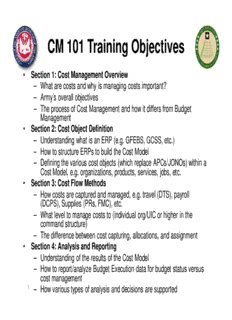
CM 101 Training Objectives - Anvari PDF
Preview CM 101 Training Objectives - Anvari
CM 101 Training Objectives • Section 1: Cost Management Overview – What are costs and why is managing costs important? – Army’s overall objectives – The process of Cost Management and how it differs from Budget Management • Section 2: Cost Object Definition – Understanding what is an ERP (e.g. GFEBS, GCSS, etc.) – How to structure ERPs to build the Cost Model –– DDeeffiinniinngg tthhee vvaarriioouuss ccoosstt oobbjjeeccttss ((wwhhiicchh rreeppllaaccee AAPPCCss//JJOONNOOss)) wwiitthhiinn aa Cost Model, e.g. organizations, products, services, jobs, etc. • Section 3: Cost Flow Methods – How costs are captured and managed, e.g. travel (DTS), payroll (DCPS), Supplies (PRs, FMC), etc. – What level to manage costs to (individual org/UIC or higher in the command structure) – The difference between cost capturing, allocations, and assignment • Section 4: Analysis and Reporting – Understanding of the results of the Cost Model – How to report/analyze Budget Execution data for budget status versus cost management 1 – How various types of analysis and decisions are supported Section 2 Objective & Agenda Section 2: Cost Object Definition • Understanding of an ERP, how to create a cost model and each of the cost objects supported within the cost model - Lesson 1: ERP Enabler -- LLeessssoonn 22:: CCoossttiinngg CCoonncceeppttuuaall DDeessiiggnn - Lesson 3: Budget Objects vs Cost Objects - Lesson 4: Cost Centers - Lesson 5: Activity Types - Lesson 6: WBS Elements - Lesson 7: Orders - Lesson 8: Business Processes - Lesson 9: Statistical Key Figures - Lesson 10: Cost Elements 2 THE $10,000 WOULD THE I FOUND A WAY TO SAVE A MILLION DOLLARS BY COME OUT OF MY CHIEF OF THAT’S WHY SPENDING ONLY BUDGET BUT THE STAFF HE IS NOT $10,000. SAVING WOULD GO INTO MIGHT INVITED TO SOMEONE ELSE’S NOT THE BUDGET. IT’S NOT AGREE. MEETINGS. FFEEAASSIIBBLLEE.. (Modified) Lesson 1: ERP Enabler Objective(s): • To understand what “ERP” stands for and how it can support the Army’s Cost MMaannaaggeemmeenntt ccuullttuurree S2L1_p 4 Enterprise Resource Planning (ERP) What is it?: • Used to refer to software/ hardware Property Supplies Accounting Property “intended to manage all information and functions of a business or Supplies Accounting company from shared data stores”* Property Supplies •• UUttiilliizzeess aa sshhaarreedd ddaattaabbaassee,, AASS--IISS LLaannddssccaappee:: ensuring data integrity, that may be • Hundreds of stand alone systems • Focus on single function centralized or distributed • Management of various software versions • Maintenance of separate hardware platforms • Manages multiple functions within a business such as Property, Accounting, Sales, Production, Procurement, etc. • Army programs such as GFEBS, ERP Shared Data Storage GCSS-A, LMP utilize the SAP ERP software S2L1_p 5 * www.wikipedia.com 11/26/09 Enhanced Ability to Capture Cost Organizational Real Property / Special Event or Cost Objects Program / Project Task / Activity Entities Equipment Initiative ERP (SAP) Assets / Real Cost Centers Project / WBS Business Process Internal Order Cost Collectors Estate Objects • BRAC • Installation • Acquisition • Services • Building • Training Event • Brigade • RDTE Project • Instructional Course •• TTrraaiinniinngg RRaannggee •• MMaannddaattoorryy AArrmmyy EExxaammpplleess •• SScchhooooll •• MMIILLCCOONN PPrroojjeecctt •• RReeppaaiirr PPrroocceessss • Weapon System Training • Directorate • System Test • Test Run • Support to • Lab Olympics Cost assigned Directly or Indirectly Customer / Product • Brigade • Weapon System • Tenant • PEO / PM • Command • Course S2L7_p 6 Many ways to Measure Cost Methodology vs System • Army’s Purpose is to Provide Operational Managers with Relevant “True” Cost Information to Make Sound Economic Decisions • Methodologies to Measure Cost (FASAB #4) - Activity Based Costing Traditional vs. Cost View (example) - Job Order (Event) costing Traditional view (Inputs) Cost View (Process) SSaallaarriieess $$ 550011KK IIssssuuee PPrrooppeerrttyy $$ 4400KK - Project (with WBS) costing Supplies 44K Receive/Turn-In Property 72K Contracts 45K Maintain Prop. Book 279K - Std. (Product) costing Travel 17K Store Property 136K Transportation 19K Administrative Support 99K - Others $626K 626K • Requires a System to Gather Cost Data and Provide Analytical Information Army Ad Financial Independent Integrated Hoc Reports Cost Models Cost Management S2L1_p 7 Requires ERP Enterprise Resource Planning (ERP) ERP Benefits ERPs Help to Streamline & Integrate the Processes & Systems Providing the Following Benefits: • Increases Productivity Across Organizations •• IImmpprroovveess SSttaannddaarrddiizzaattiioonn && EEffffiicciieennccyy ooff PPrroocceesssseess • Increases Access, Consistency & Transparency of Data • Provides Collaboration Across Business Domains • Provides IT Economies of Scale • Enhances Analytics & Improves Accuracy of Data S2L1_p 8 Enterprise Resource Planning (ERP) Commercial Off the Self System that Integrates All Facets of the Business End User Presentation Layer DD aa tt aa WW aa rr ee S hh B oo E uu F ss ii G nn gg AA nn aa ll yy tt ii cc ss S2L1_p 9 Fundamental Shift – Operationally Focused Accounting Accounting ss ll aa ii cc DODAAC/UIC -> APC/JONO nn aa Crosswalks nn ii FF >> - Supplies s Property n Property o i t a r Supplies e Supplies Property p O AS-IS Landscape: TO-BE Landscape: • Operational systems tend to work on DODAACs • Operational functions integrated with Financial and UIC processes • Financial systems work on APCs/JONOs • Focus of system is capturing operational • Crosswalks/systems are maintained to align transactions which then provide a financial view operational level of detail to correct financial • Level of information capturing is far lower than view, e.g. FCM Financial focused system dealt with, e.g. by full S2L1_p10 6 UIC code versus parent AA
Description: